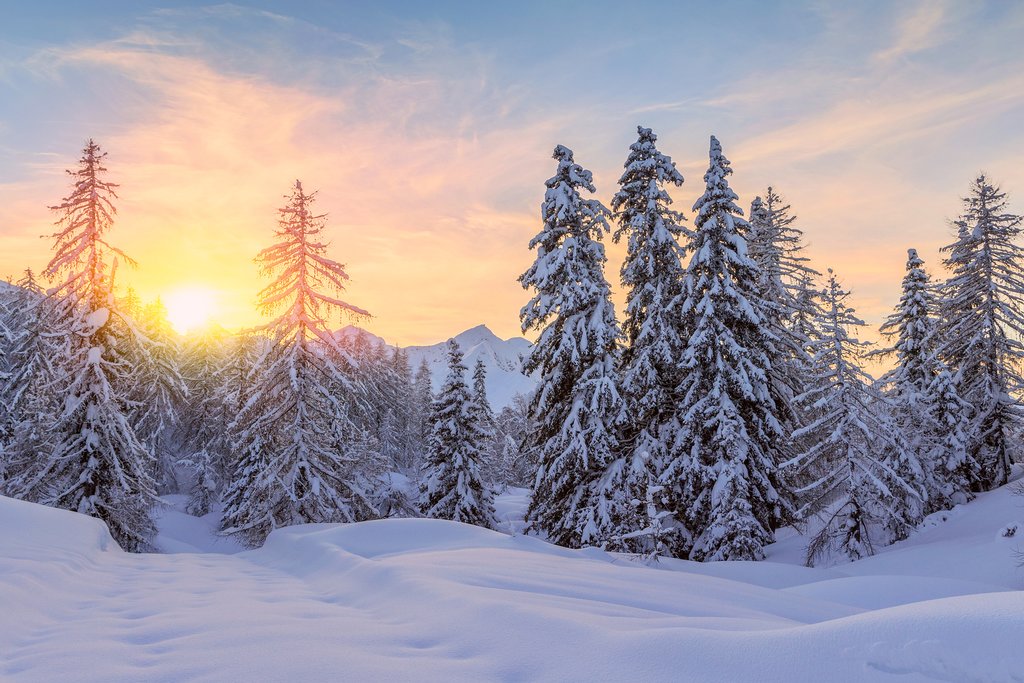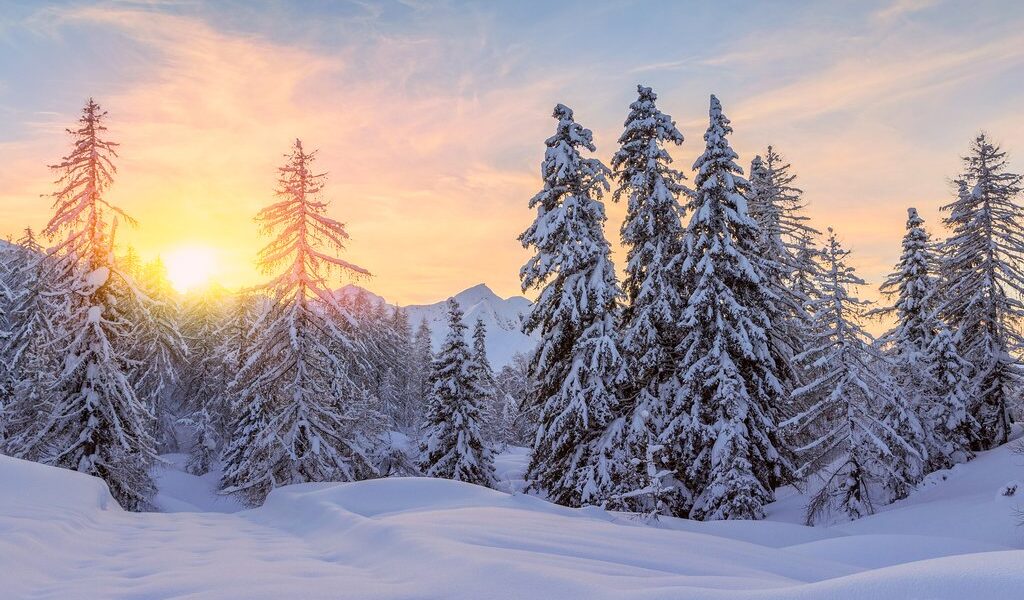
February is the last full month of winter in Slovenia, offering plenty of snowy adventures and lively festivals—as well as fewer tourists and lower prices. Ski season is well underway in the mountains, the resorts and their respective slopes bustling with activity. Meanwhile, the rest of the country celebrates the coming of spring with Lent and Mardi Gras celebrations.
## Weather in Slovenia During February
The weather along the short but beautiful coastline of the northern **Adriatic Sea** in February presents a rather mild experience when compared to other regions within the country. Average temperatures during this month typically fluctuate between 37°F to 46°F (3°C–8°C), creating a generally pleasant environment for exploration and sightseeing. However, visitors should remain aware of the potential for sudden temperature drops, especially when the infamous Bora winds decide to make their presence known. These winds can dramatically alter the weather conditions, so being prepared is always a good idea. While the cities nestled within this coastal region tend to experience the least amount of rainfall throughout the year, it’s still highly recommended to pack essential rain gear. Alongside your waterproof attire, ensure you bring along warm layers and other winter necessities to comfortably navigate any unexpected weather changes.
Venturing inland, towards the captivating capital city of **Ljubljana**, travelers can anticipate a slight decrease in temperatures. During February, temperatures in **Ljubljana** often hover below 43°F (6°C). Interestingly, despite the capital’s reputation as one of the rainiest cities in Europe, February offers a relatively drier spell. On average, the city experiences only about 3.5 inches (9 cm) of rainfall spread over approximately nine days throughout the month. This provides a welcome respite for those looking to explore the city’s many attractions.
For those with a penchant for high-altitude adventures, the mountainous regions present an entirely different weather scenario. In the high mountains, February brings with it substantial snowfall and consistently sub-zero temperatures. Expect average lows to plummet to around 19°F (-7°C), while highs struggle to climb above 39°F (4°C). This makes the mountains a haven for winter sports enthusiasts, but also requires appropriate gear and preparation to ensure a safe and enjoyable experience.
## Crowds and Costs in Slovenia in February
February in Slovenia generally falls within the offseason for tourism, despite being a popular month for ski enthusiasts. The combination of cooler weather and fewer daylight hours contributes to a more relaxed pace of travel across much of the country. As a result, travelers can often benefit from lower prices on flights and hotels, making it an attractive time to visit for budget-conscious individuals, excluding, of course, the ski resorts where prices may be at their peak.
February also marks the beginning of the transition towards spring, with Mardi Gras celebrations taking place in various locations throughout Slovenia. These festive events can draw crowds, so it’s advisable to plan accordingly if you wish to participate or avoid them altogether. Whether you’re interested in joining the Mardi Gras festivities or prefer a quieter experience, booking your accommodation and restaurant reservations in advance is always a prudent step. This will help ensure a smoother and more enjoyable trip, allowing you to focus on exploring and experiencing the beauty of Slovenia.
## Where to Go in Slovenia During February
Despite its relatively small size, Slovenia boasts a rich tapestry of culture and natural beauty that can be enjoyed throughout the year. Many visitors choose to begin their Slovenian journey with a few days in the charming city of **Ljubljana**. Here, you can immerse yourself in the city’s atmosphere by strolling along its enchanting cobblestone streets, admiring its medieval architecture, and exploring its diverse array of art galleries and museums. For those seeking inspiration on how to spend a perfect day in **Ljubljana**, there are many suggested itineraries and guides available.
Beyond the capital, other historic cities are well worth considering for your Slovenian adventure. **Ptuj**, located in the eastern part of the country, offers a glimpse into Slovenia’s rich past, while the uncrowded coastal towns of **Portorož**, **Piran**, and **Koper** provide a tranquil escape along the **Adriatic Sea**. These coastal gems also serve as excellent starting points for exploring the Karst region, which is home to some of Slovenia’s most famous caves, including the magnificent **Škocjan** and **Postojna**.
For those seeking the thrill of snow sports and a cozy resort atmosphere, the mountains beckon with open arms. **Kranjska Gora** is a popular destination, attracting both international and local visitors alike. Here, you can indulge in crackling fires, warming cocktails, and therapeutic spas after a day on the slopes. However, it’s important to note that due to heavy snowfall during February, the **Vršič Pass** in the breathtaking **Julian Alps** is likely to be closed to traffic.
## What to Do in Slovenia in February
As the days gradually lengthen in February, it presents an ideal opportunity to partake in a range of winter activities and cultural festivals that celebrate the approaching arrival of spring. If you’re a fan of skiing or snowboarding, head to **Kranjska Gora** to hit the slopes and experience the exhilaration of gliding down the snow-covered mountains. For a truly unique experience, consider spending a night in an igloo, immersing yourself in the winter wonderland.
If skiing isn’t your preference, there are plenty of other winter activities to enjoy. Try snowshoeing through pristine forests, or experience the thrill of night sledding under the starry sky. Alternatively, you can venture to the **Golte Ski Resort** for some cross-country skiing, or warm up with a glass of local wine in a unique ice bar at the **Kravec Ski Resort**.
For photographers, **Triglav National Park** is a must-visit destination. The park offers breathtaking vistas of snow-laden peaks and forests, providing endless opportunities to capture stunning winter landscapes. **Lake Bohinj** and **Bled** are also particularly beautiful during this time of year, having undergone a seasonal makeover with their snow-covered surroundings.
Since most of Slovenia’s caves remain open to the public year-round and maintain a consistent interior temperature, February is an excellent time to explore these subterranean wonders. With fewer tourists compared to the peak season, you can enjoy a more intimate and unhurried experience as you marvel at the unique geological formations.
For those who enjoy a festive atmosphere, February and early March are prime times to experience some of Slovenia’s best festivals, which often revolve around Shrove and Lent in the lead-up to Easter. These celebrations provide a glimpse into Slovenian culture and traditions, offering a memorable and enriching experience.
## Events in Slovenia During February
* **Kurentovanje**, **Ptuj**: This vibrant festival in **Ptuj** celebrates the rites of spring and fertility, lasting for 11 days and culminating in the spectacular Kurent parades.
* **Pust**, **Cerknica**: A lively four-day festival in **Cerknica** where masked revelers and witches parade through the streets on the weekend before Ash Wednesday.
* **Laufarija**, **Cerkno**: **Cerkno** hosts a centuries-old and unique carnival, welcoming the arrival of spring with traditional customs and festivities.
* **Prešeren Day**, **nationwide**: Celebrated across Slovenia on February 8th, this national holiday honors Slovenian culture and the renowned poet, France Prešeren, who passed away on this day in 1849.
B-2250

